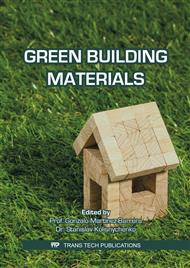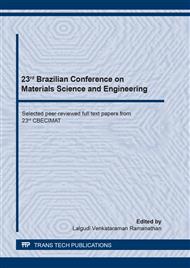p.227
p.233
p.239
p.244
p.250
p.256
p.262
p.268
p.272
Effect of the Incorporation of Marble Waste in the Properties of Clay Ceramic Bricks
Abstract:
Residues incorporation into construction building materials is a promising sustainable alternative for the correct disposal of this kind of material. Brazil is one of the largest world producers of ornamental stones. Nevertheless, the disposal of these residues usually is made outside the industry, which contributes to environmental pollution. This work aimed to evaluate the incorporation of residues from the marble industry into ceramic bricks. Specimens of clay ceramic containing 10, 20, 30 and 40 wt.% of marble residue were prepared and fired at 900oC. The evaluation of the ceramic bricks added with marble residue was based on linear shrinkage, water absorption and mechanical resistance. These properties were compared with Brazilian standards. It was concluded that the incorporation of marble residues, with up to 20 wt%, into the ceramic body is technically feasible and positively influences the properties of the material.
Info:
Periodical:
Pages:
250-255
Citation:
Online since:
October 2020
Price:
Сopyright:
© 2020 Trans Tech Publications Ltd. All Rights Reserved
Share:
Citation:



